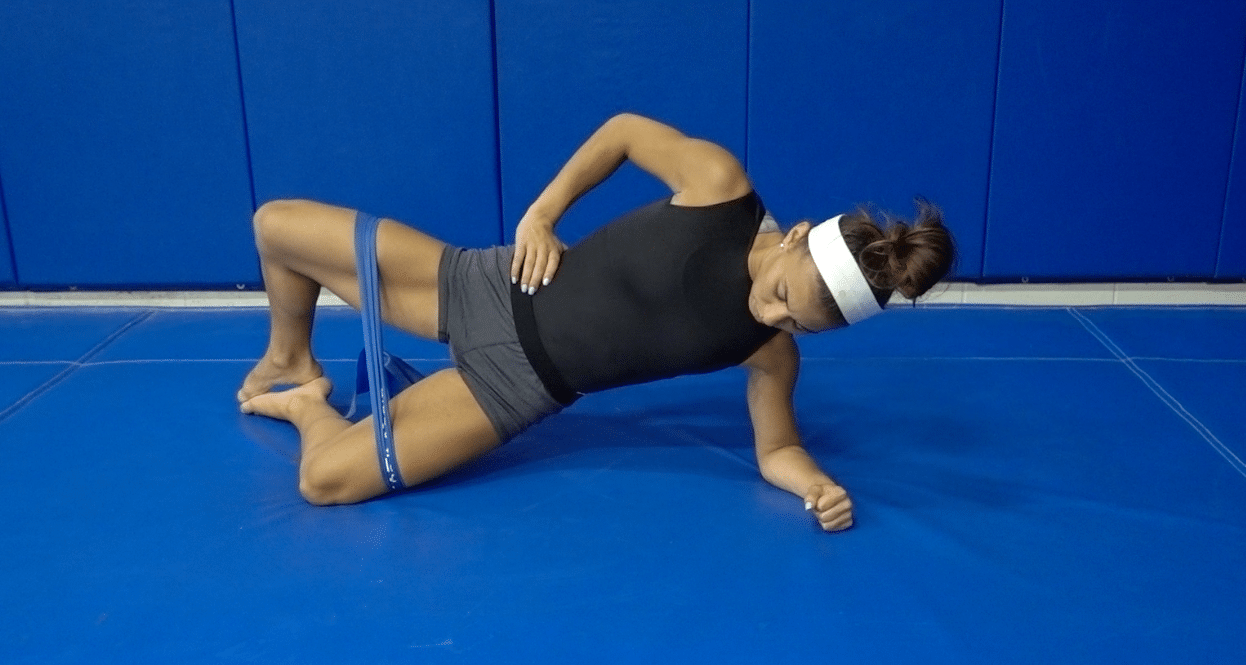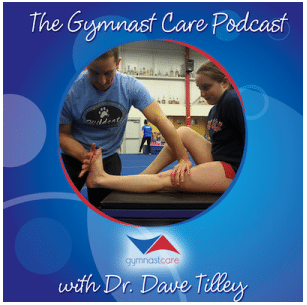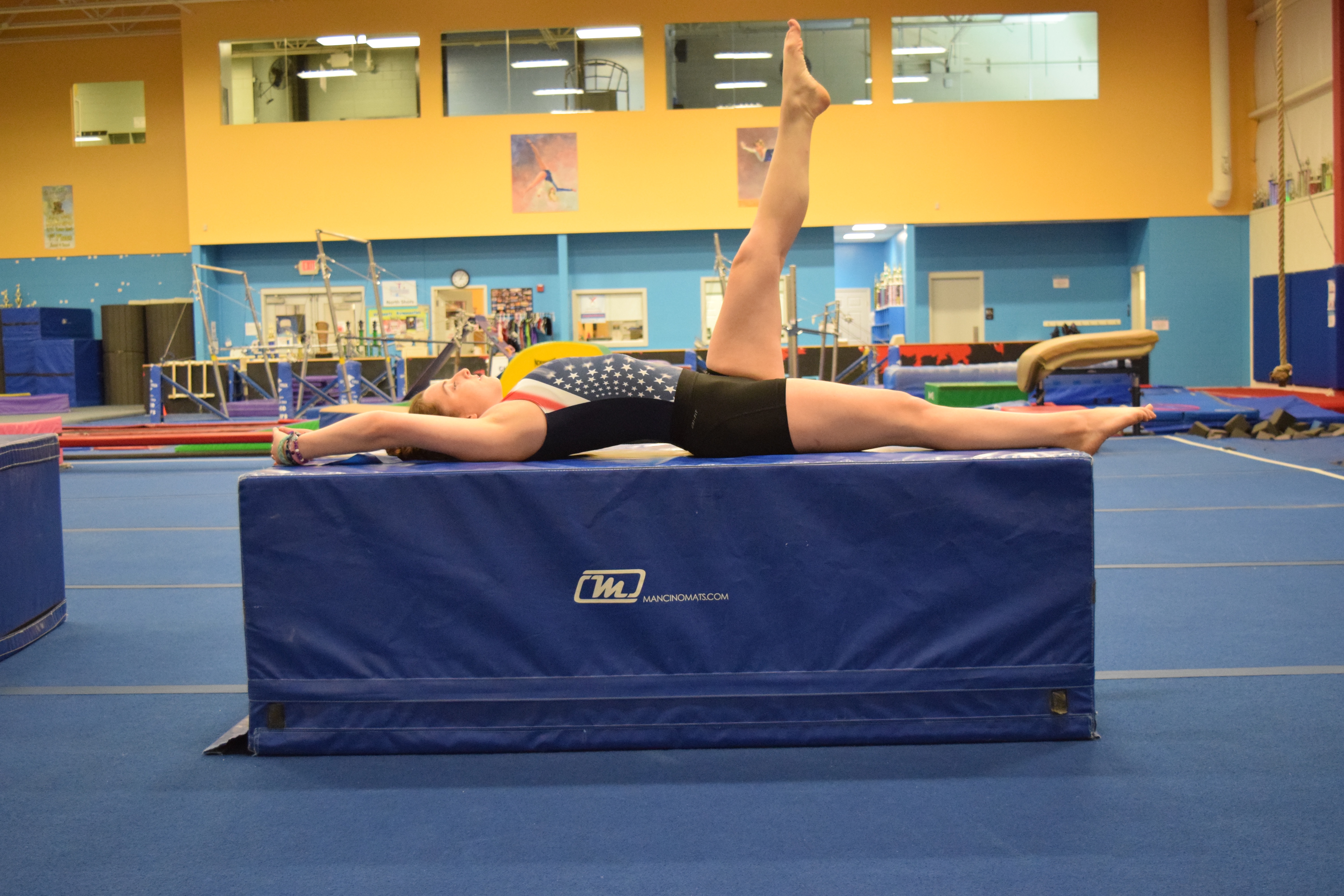5 Reasons Why I Don’t Push My Gymnasts Down During Splits – Part 2
The response to Part 1 of this post was incredible and ended up being one of the most viewed pieces of content on the site. I got some great feedback and it was awesome to see people enjoyed it. I think it’s a topic many people involved in gymnastics think about. So what’s a coach to do? As promised, here’s part 2 that has a few more points behind my opinions and then a handful of alternatives to gaining mobility in gymnasts.
Table of Contents
3. The Effects/How Long Mobility Changes Last
There is some literature available looking at current theories about what is really going on when we get into the stretching realm. This really isn’t a post to look at these different theories, but in short what is actually being “stretched” and how long the effects actually last are up in the air. More importantly, theories support the notion that when we push a stretch we may really just be reducing a persons sensitivity to stretch or making temporary neural changes, rather than making any tissue length changes. I haven’t explored all the research (I’m always open to learning more), but my searching so far has pushed me more towards alternative methods.
Along with this It’s really hard to know as a coach what your feeling when you get to a restricted motion. Is it muscle? Protective guarding ? Fascia? Joint capsules? Bone approximation? Hard to be sure without process of elimination. I don’t think it’s the best choice to just hammer away not knowing what types of tissues or structures your pushing on hoping for the best.
If someone does have restrictions, as a coach and PT I want to
- Find out why they have restricted mobility through a movement assessment
- If mobility work is appropriate, investigate some non threatening ways to increase the mobility
- Teach the gymnast how to use it during skills/maintain it on their own
- Ingrain the mobility into skill work with good control drills, technique tweaking, and coaching progressions
I know that people may not have a PT background to go about that process, but there are many resources (continuing education or other people) to help out. I can tell you that there have been many times I have been able to see rapid changes in peoples “tightness” by using good positioning and some other methods. It doesn’t always happen like that, and sometimes it takes trial and error to see what technique works for that person. But I think there are some other ways to go about it, along with being consistent, to help make changes.

4. Is It Doing More Harm Than Good?
This is really one of the biggest reasons that I made this post. The videos or blog posts I see with aggressive stretching make me really nervous. Sometimes I just have to cringe a bit, and there are other times that I legitimately get concerned for the gymnasts safety. I think the pain gymnasts report is sometimes assumed to be “muscular” without further investigation.
The majority of gymnasts are already hyper mobile or “bendy”. This means they naturally move a lot and have increased motion throughout their body. It’s probably the reason they got into gymnastics in the first place, or made it so far as part of a natural selection type concept. Controlling that large range of motion is critical. There are two versions of stability that can be used for this.
- Static Stability – is composed of things out of our brains active control like boney alignment, ligaments, cartilage, and other passive structures
- Dynamic Stability – composed of the things we can control like neuromuscular connections, working coordination/timing of movements, teaching sequencing, good technique, and building strength
Here’s a gymnastics example to help compare the two. If a gymnast stands in a large hyper extended arched back posture, they are more resting on static stability from the bony alignment, joint capsules, facet joints, ligaments, and so on. It’s easy and takes no effort to be stable, but it placed quite a bit of stress on these structures over time.
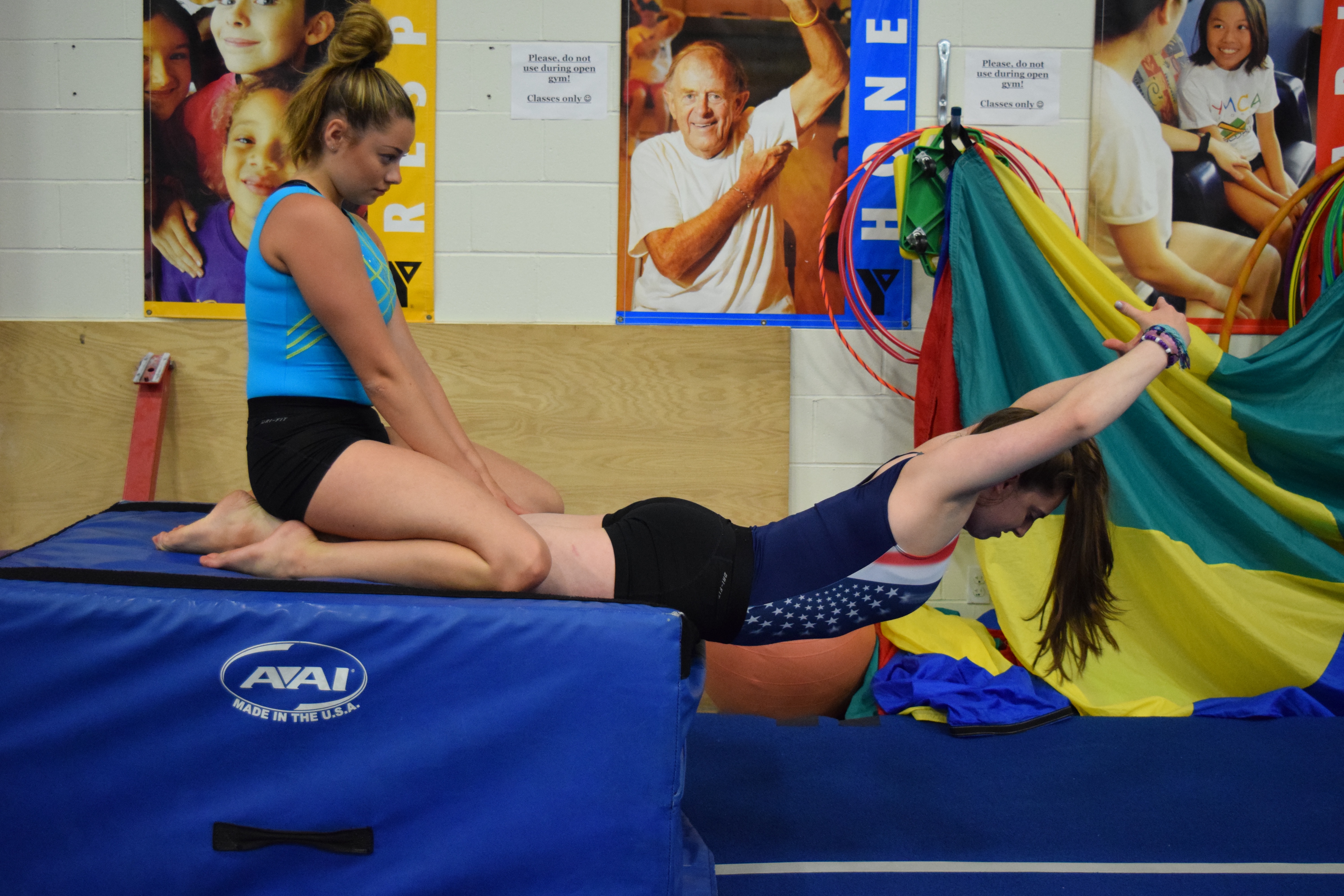
This is why we need to be on our gymnasts when they stand with their belly sticking out all the time. If the gymnast were to assume a more aligned position and trigger muscular support from dynamic stabilizers, the muscles could shift stress away from the joints/ligaments/etc. It’s more work overall, but it is key in preventing excessive stress on static structures and also assists in power output for gymnastics skills.
If the gymnast is naturally lax and loosey goosey, it means that they probably don’t have great static stability. These are the gymnasts that can bend their back in half doing a bridge, or do huge oversplits in every direction easily. When we aggressively stretch on a gymnasts splits or bridges, chances are the overpressure and extreme positions are further lengthening the already lax static stabilizers.
And even for the “tight” gymnast (which I raised arguments for in part 1 last week), improper stretching and compensation lead to just mobilizing the same static structures rather than maybe the soft tissue your aiming for. To continue to lengthen these structures is extremely dangerous and may also contribute to bigger problems down the road with high force gymnastics. I think things get dicey when we take a gymnast who may not have good control, further stretch their static stabilizers, then have them do gymnastics skills that expose them to huge forces that they need that stability for to stay safe.

Over Extended Quad Stretch
Think about if someone yanks on a gymnasts shoulders hard or cranks them over on a bridge, then asks them to grip up and swing giants (which may subject the shoulders to distraction forces 3-4x body weight). I know many coaches and gymnasts jump right to how lines look better during skills and that we need those extreme range of motion. But like I said I’m not sure if with the method of aggressive stretching is the way. I urge people to consider the pro to con ratio with all of this, and think about the global picture of the gymnast.
5. There Are Other, Less Threatening Ways –
Like I talked about last week, aggressive stretching and flexibility routines can trigger the ‘danger system’ and increased perceived threat by the brain. This may then lead to not only dangerous situations, but also ineffective time in the gym combined with points mentioned. If someone does have a mobility restriction, or are looking for good ways to go about maintaining their mobility there are better ways to go about it.
Before I share those, remember that you can download the exact flexibility and pre hab circuits I use with gymasts every day for free. Just enter your information and it will be sent to your email,
Download My New Free
10 Minute Gymnastics Flexibility Circuits
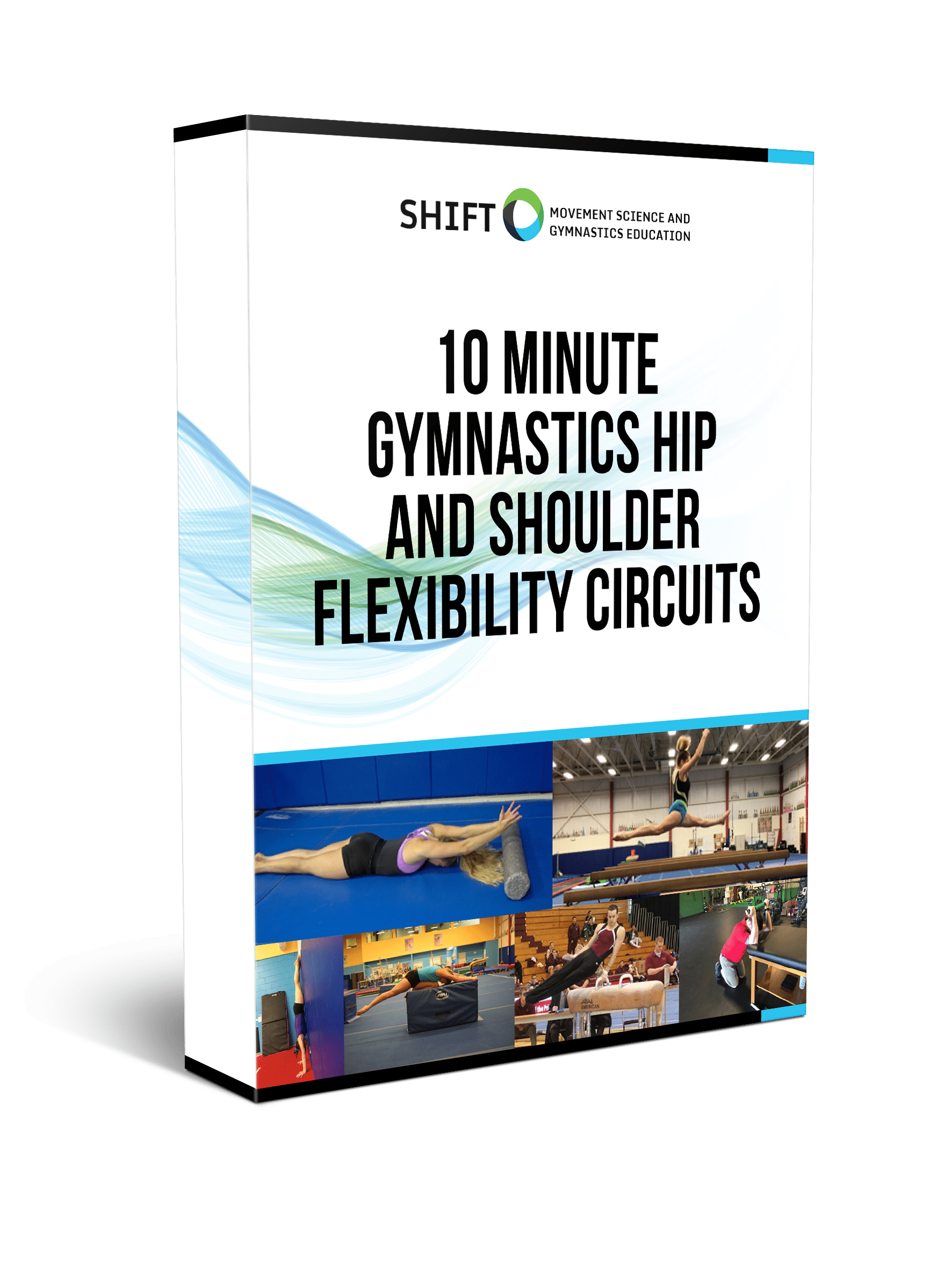
- 4 full hip and shoulder circuits in PDF
- Front splits, straddle splits, handstands and pommel horse/parallel bar flexibility
- Downloadable checklists to use at practice
- Exercise videos for every drill included
Download SHIFT's Free Gymnastics Pre-Hab Guide
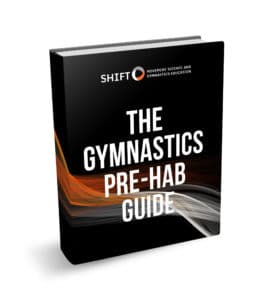
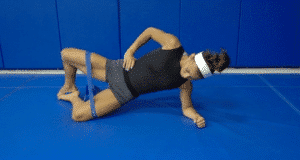
Daily soft tissue and activation exercises
Specific 2x/week Circuits for Male and Female Gymnasts
Descriptions, Exercise Videos, and Downloadable Checklists

Here are 5 suggestions I use,
1) Daily Mobility/Activation Work
Prior to their warm up, I have my girls do 10 minutes of prep work before they start their dynamic warm up. It is a one page program that goes through soft tissue for commonly restricted (or sometimes up regulated) areas on gymnasts like the calves, quads, groin, hip flexors, lats, pecs, etc. I then have them go through some activation drills for commonly weaker (or sometimes down regulated) areas like the shin muscles, hamstrings, glutes, inner core, shoulder blade muscles, etc). After this we do our dynamic work up, work some whole core control and breathing drills, then integrate them into things like proper squatting/jumping form. I’m not inventing anything new here, as I have learned these principles from other great continuing education resources. I’ve just taken the concepts, adapted them with my gymnastics knowledge, and tried to find a feasible way to implement them in the gym. I think that this type of “pre-warm up” program is key, and I’m going to try and get some videos together for people in an upcoming post series.
2) Proper Form and Good Technique
Gymnasts are really good at compensating around their individual mobility limitations to make the overall movement pattern (split, bridge, pike) look better. It may look good to the eye, but might be causing lots of undue stress under the surface even if there isn’t any pain. Tuning in to proper positioning and using proper alignment can go a huge way in terms of addressing the area your actually looking to mobilize. Many coaches I think have this on their mind and are correcting technique/form, and the overall picture of the position (turn your back knee under, chest tall).
Take the common example of many gymnasts simply arching their back more to get a split lower, rather than actually neutralize their spine/hips and get a hip flexor stretch/hamstring stretch. If were looking to open a hip flexors there are much more effective ways to isolate and properly work the motion rather than just force the gymnasts into positions and push possibly driving more compensation. To line up a good mobility drill make sure your finding the ideal position, cueing good core activation with breathing (next point) and teaching the gymnast to actively work into the motion rather than just be lazy and hang out. Honestly, often times it takes coming out of the stretch a little bit to correct for perfect alignment and sacrificing motion to get good technique.
3) Proper Breathing Patterns
Breathing literally drives everything that we do, both in a daily movement situation but also as it relates to powerful high level gymnastics. This is a really big concept that I hope to post more on soon. Simply put we have to be able to teach/harness proper breathing patterns in our gymnasts in order to minimize injury, maximize performance, and also help influence increased mobility. I can safely say there hasn’t been a gymnastics patient in the last year I haven’t worked breathing with, and it’s a huge focus of my own athletes. Integrating breathing patterns before practice in the “pre warm up” to calm the gymnasts nervous system down is one key in order to help enhance mobility work. If we can calm the nervous system down and possibly help drive less “danger signal”, then we might have more success with flexibility work. During flexibility and dynamic warm ups, I encourage the gymnasts to find the position with good technique, and use proper breathing to gain motion.
4) More Specific Daily Work/Homework For Gymnasts Who Need It
I’m very aware that there are gymnasts out there who are just naturally prone to restriction, and have a tougher time with mobility work. Like I said, first we have to investigate why they are tight in the first place. A movement assessment from a healthcare provider can help really narrow in on whats limiting their motion. However, if they fall into the mobility category it may take a little more homework to clear up because gymnastics demands more than average mobility across the whole body. I often times give gymnasts homework to work on the techniques above, or individual programs they come in early to do. Remember it’s the athlete’s job to take ownership of their gymnastics, and find time for their weakness areas that need more attention. Getting more mobile does sometimes times just take some dedication and consistency to make changes. Make sure they aware aware of why they need it, how to do it properly, and explain the benefits it can cause both in terms of injury risk and increasing performance. I find when you take the time to educate them they are much more on board.
—————–
So that concludes this two part series, and I hope people have taken some cool ideas away from it. Going to be getting back to a few unfinished posts on the Joint by Joint approach to handstands, and also a few new ideas I’ve had brewing. Best of luck,
Dave
References
- Hargrove, T. A Guide To Better Movement. The Science and Practice of Moving Better With More Skill and Less Pain; 2013
- Cook G. Movement: Functional Movement Systems: Screening, Assessment, and Corrective Strategies. Aptos, CA: On Target Publications, 2010.
- Sahrmann, S. Diagnosis and Treatment of Movement Impairment Syndromes; 2001
- Oscar E. Corrective Exercise Solutions to Common Hip and Shoulder Dysfunction. Lotus Publishing: California; 2012
- Cynthia H.w., Magnusson P., Increasing Muscle Extensibility: A Matter of Increasing Length or Modifying Sensation? PHYS THER. 2010; 90:438-449.
- Ben M, Harvey LA. Regular stretch does not increase muscle extensibility: A randomized controlled trial. Scand J Med Sci Sports. 2010;20(1):136-144. doi: 10.1111/j.1600-0838.2009.00926.x.

